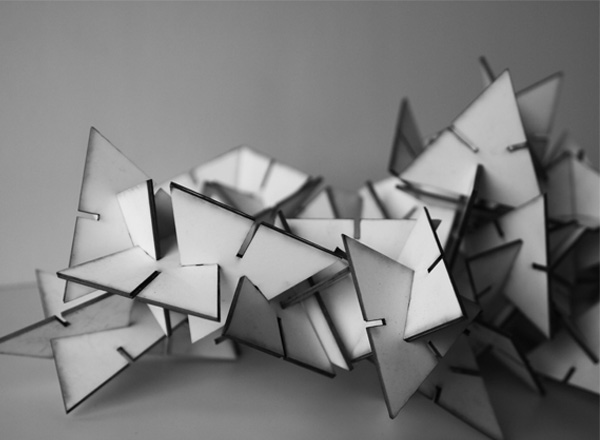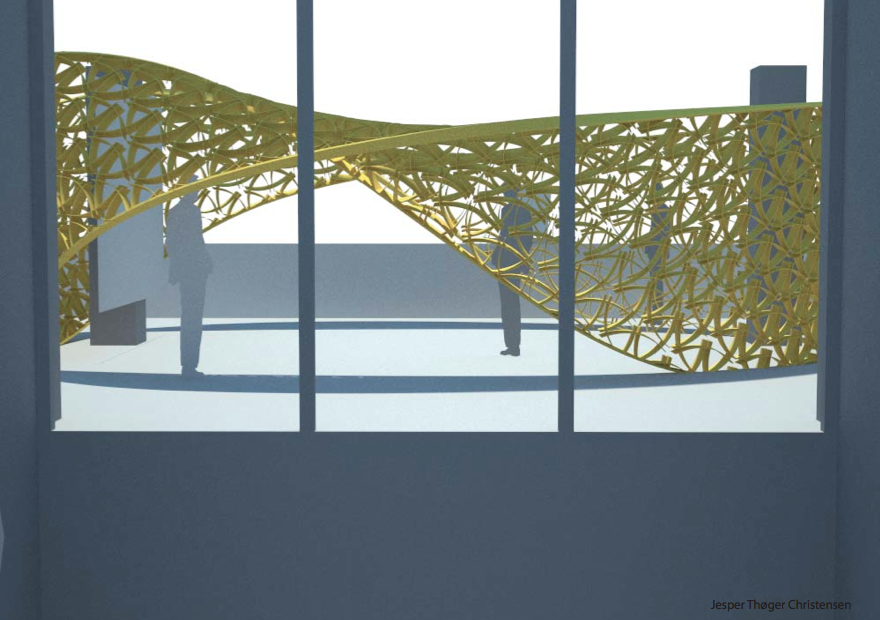M3:Design Competition: Intermediate Critique
Within one week each student had the task to design a free standing “Parametric Paravent”. The structure had to be made from CNC-produced components that connect via a simple, rule based system. Self defined external factors would work as parameters to introduce variation into the structure. All components should be designed according to a system that allows for both simple fabrication and setup. The use of additional fasteners and materials should be kept to a minimum.The design of both components and final structure were continuously tested and verified by physical experiments. The Paravent had to be 2.30m high and at least 3m in length.Each student had to submit a 3pages pdf and a 1:10 model of a wall segment of the proposed design.The jury, consisted of the CAAD and Mathias Kohler, DFAB, was then select two or three projects for further development. All other students was re-distributed into the winning teams. Each student had 10 minutes to defend his idea.
STUDENT WORKS
Agata Muszynska
Magda Osinska
de-puzzle fighting magda osinska
1. assumptions.The idea is to study the interactions and relations between elements in a self-organized structure, in this case in the conference room in CAAD,HPZ Floor F building in ETH Campus.The project proposes that the relation between elements (their freedom and intelligence), can generate the structure, not the structures generate the elements.Using the idea of complexity , between every element there is cross level transformation.How very simple, abstarct rules can produce very complex system and complex behaviors?How important are the connectors and their relations? How important is one function which can organize all the structre? How important is the „smart“ elastic script, which define how to design something not defining a goal?How to code the relation between elements(not using an order for the components) and create the cooding system which allows to modify the model at every stage of the work.Implementing a few set of rules :elastic connections,autonomy of elements, individual details, free ordering of elements An easy system can become more complex … 2.logics.Loking for the logics the reserach started from the Cellular Automaton by Wolfram.A cellular automaton is a collection of “colored” cells on a grid of specified shape that evolves through a number of discrete time steps according to a set of rules based on the states of neighboring cells. The rules are then applied iteratively for as many time steps as desired.The overal plan can be replaced by writing relation between elements.it is unknown how the final product will look but it is needs the set of rules(local inteligence) which will create the whole system. Looking futher that puzzle has similar logic and thay study only relation between the similar neighbor but each element is different.I create the first game…3.typology- how they are organize?first idea – diagamatic representation of designed programme the processes of system generating , being a result of setting up few rules: the program generates structure by amplifying 2 simple rules,creating in the same time complex structures: 1-every element muliplies by creating another one in the space joint the apex, 2- when 2 elements in the generation process become touching each other in the edge-one of them wins and one looses.4.construction detailsThis game gives infinitive numbers of solutions and  the possility to establish the connection between two elements.What will happend if I de-p-u-z-z-l-e my game…?Searching further for rules allowes to find the solution where all elements would be dependent of each other and could create entire systems.The location and relation between elements are determined by conectors. In the project we had to use 6mmMDF and maximum hight the structure was 280cm.The first idea was to find the rules of a joint system, which allows to connect different elements in different possitions but the stabilization of system was a concern.5.construction details- looking for solution…The next step is to establish the strategy for the relation between elements.The material and construtions detail provide the constrains and help setting up rules.In the several studies some important rules emerge.
Jesper Thøger Christensen
Jesper Thøger Christensen presentation
Jorge Orozco
Hideaki Takenaga
Mihye An
Nikola Marincic








